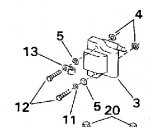aaasnapper
Cadet
- Joined
- Sep 4, 2010
- Messages
- 12
I have had an issue with misfire on #1 piston.
I had checked out all components (using DVA meter) and replaced power pack, charge coil and ignition coils. (mainly becuase the issue was not resolved)
The engine idles fine and is fine at high revs.
The misfire only seems to occur after the engine has warmed up and when the engine has gone from higher revs back to idle and then as you try to increase the revs the misfire occurs at a certian rpm then it takes off and is fine. However, backing off on the rpms will make it misfire again.
I had checked out all components (using DVA meter) and replaced power pack, charge coil and ignition coils. (mainly becuase the issue was not resolved)
The engine idles fine and is fine at high revs.
The misfire only seems to occur after the engine has warmed up and when the engine has gone from higher revs back to idle and then as you try to increase the revs the misfire occurs at a certian rpm then it takes off and is fine. However, backing off on the rpms will make it misfire again.




















